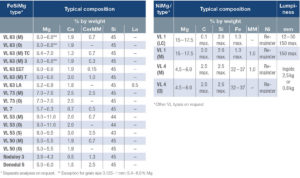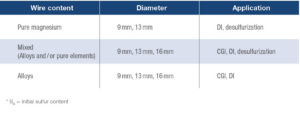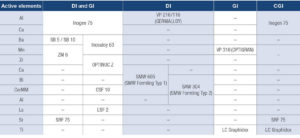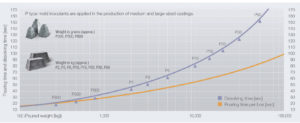
MASTER ALLOYS FeSiMg and NiMg
Magnesium treatment is a required step within the production of ductile (DI) iron and compacted (CGI) iron. The primary purpose of introducing magnesium to the molten metal is the formation of spherical graphite, also called spheroids or nodules (DI) and compacted graphite (CGI) respectively. These graphite forms, when produced correctly, are essential to provide the iron with the desired mechanical properties.
- Your benefits
- Produced to the highest quality standards
- Critical elements maintained at narrow limits
- Methods for introducing the pre-alloy


CORED WIRE
INFORM M for magnesium treatment
INFORM M cored wires are a highly effective and reliable method for introducing magnesium to molten metal. These highly innovative wires are designed in multiple diameters. They are extremely easy to handle and ideal for automation processes. ASK Chemicals INFORM M cored wires are guaranteed to have been produced to the highest quality.
- Your benefits
- Well-adjusted compositions to your specific foundry needs
- Small addition and exact dosing
- Simple handling, easy to automate
- Good traceability and documentation
- Mg cored wire treatment for DI and CGI
- This offers flexibility with regard to changing initial conditions such as the sulfur content, treatment temperature, and iron quantity.
- Additionally, relatively constant Mg values can be achieved despite different initial sulfur values and treatment temperatures.
- Lastly, handling and treatment costs can be reduced. Environmentally friendly because of targeted exhausting.
Classification of Mg-treatment wires

INOCULANTS Ladle, in-stream and cored wire for varying applications
ASK Chemicals Metallurgy offers a wide variety of engineered inoculants for gray (GI), ductile (DI) and compacted graphite (CGI) iron. Each inoculant is unique in design to provide performance characteristics that satisfy today’s demanding casting requirements. These inoculants are produced at our German facility under strict quality control.
- Your benefits
- Very good dissolution behavior
- High effectiveness and low consumption
- Uniform graphite precipitation
- Improvement of mechanical properties
- Methods for introducing the inoculants


MOLD INOCULANTS
GERMALLOY, SMW Inserts and OPTIGRAN
GERMALLOY and SMW Insert are solid cast inserts used for the mold inoculation of ductile iron. They are either placed in the drag portion of the mold or anchored in the pouring basin of very large castings. GERMALLOY is widely used to improve the nodule count of graphite within a casting, as well as enhance its mechanical properties. SMW Insert inoculants, on the other hand, are well known for their ability to eliminate the formation of chunky graphite in heavy section ductile iron. OPTIGRAN is the mold inoculant for gray iron. It provides finer Type “A” graphite in gray iron. Pouring and dissolving time of ASK Chemicals mold inoculants*


PRE-CONDITIONERS Products that ensure a well-prepared base iron
Preconditioning establishes constant conditions in the molten metal. It is important to achieve a proper chemical composition of oxygen and sulfur, especially for the subsequent Mg-treatment processes. It is of upmost importance to achieve process stability, create a uniform base iron and improve the nucleation state of the molten metal. With the pre-conditioning products, ASK Chemicals provides, all of this can be achieved. ASK Chemicals has a wide array of products within this segment to meet your every need

MELT CLEANERS The cleaning of the melt and the reduction of deposit to ladle and furnace linings are essential for the molded part quality and reduction of maintenance costs. Avoidance of slag ladles and casting and melting furnaces
REDUX is a reliable product for reducing slag on casting ladles and casting/smelting furnaces. The product is a fluoride-free flux that can help to prolong the life of ladle and furnace linings. REDUX also helps to remove any impurities from the melt. Since REDUX L reduces the surface tension of the molten metal, it assists the coagulation of foreign particles or reaction products, which can thus rise at an accelerated rate.
- Your benefits
- Reduction of deposits on the ladle and furnace lining
- Reduction of existing slag deposits
- Preconditioning of molten metal
- Reduction of dross and slag inclusions
- Melt Cleaning with DISPERSIT
DISPERSIT is a new method of metallurgical purification of molten iron. DISPERSIT reduces the surface tension of the molten metal and assists the coagulation of foreign particles or reaction products, which can thus rise at an accelerated rate. In addition, DISPERSIT reduces the formation of reaction product (slag) deposits on the treatment ladle, pouring ladle and pouring furnace lining. When using DISPERSIT, the addition of alloys containing Mg can be reduced during the production of cast iron with nodular graphite. For example, 1 kg DISPERSIT is generally a substitute for 1 – 2 kg of a 5 % FeSiMg alloy; there are corresponding empirical values when using other FeSiMg alloys. The use of DISPERSIT is often successful in reducing the scrap rate caused by dross and inclusions by over 50%.
- Your benefits
- Preconditioning of molten metal
- Reduction of slag on the ladle and furnace lining
- Reduction of dross and slag inclusions